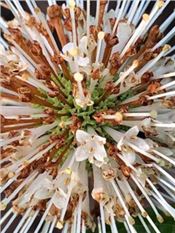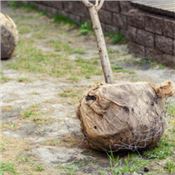Gardening Page
Small Bees Attracted To Small Flowers

Plant small flowering plants such as yarrow to support small pollinators. Yarrow cannot pollinate itself and relies on the service of small bees.
KELLY ALLSUP
URBANA, ILL.
While the bumblebee is likely the most well-known pollinator, pollinators come in a variety of shapes, species, and sizes.
Many entomologists believe the tiny sweat bee nectaring on your flowering weed is just as important to a healthy ecosystem as the more well-known bumble bee and honey bee.
Gardeners and homeowners can make a space more attractive to the small pollinators of Illinois by planting miniature flowers. These little bees, about the size of an ant, love pollinating miniature flowers in an urban environment where there is usually more floral diversity than in rural areas.
When spring comes, instead of cutting your garden back to the ground, consider removing only the top of the stems to encourage opportunistic bees like small carpenter bees to make nesting cells to overwinter in.
Small Bees to Look For
Small sweat bees, Lasioglossum, are dark brown, gray, black, or metallic with hairs on their legs and abdomen giving them a fuzzy appearance. These pollinating bees nest in bare ground that has loose soil. They nest individually, but there may be multiple nests in one area.
Small sweat bees are especially attracted to a much-beloved Illinois native shrub, button bush, or Cephalanthus occidentalis.
Button bush boasts minuscule tube-shaped florets on a globular white seed head in the middle of summer, followed by an ornamental red seed head. This large shrub grows to about 6 to 8 feet and can form thickets in wet environments.
Yellow-faced or masked bees, Hylaeus, are dark bees that look like wasps with their yellow or white face markings. Lacking the hair of typical pollinating bees, these tiny bees ingest pollen and nectar, then regurgitate the mixture in nesting cells to feed larvae when they hatch.
This pollinator emerges in the late spring when the bold flowers of golden alexanders, Zizia aurea, begin to bloom and remains active until the compound flowers of goldenrod, Solidago spp, start to fade.
Yellow-faced bees can be seen pollinating the miniature white and purple flowers of common mountain mint, Pycnanthemum virginianum.
These small flowers are arranged in clusters that bloom in late summer.
Small carpenter bees, Ceratina, which are black and metallic blue, excavate the center of small stems in the garden. They have fine pollen-collecting hairs on their legs and carry pollen and nectar back to the nest within the stem.
Small carpenter bees are attracted to small flowers of spring-blooming pussy willow, Salix spp, and summer-blooming yarrow, Achillea millefolium. Yarrow flowers cannot pollinate themselves and rely on the service of small bees. ∆
KELLY ALLSUP: Horticulture Educator, University of Illinois
Tips For Planting Balled-Burlapped Trees For Long-Term Health, Success

CHRISTOPHER ENROTH
URBANA, ILL.
Fall is a great time to plant trees, many of which are originally grown at a nursery either in a plastic container or in the ground before they are balled and burlapped. How the tree is grown in its first years and then planted affects the long-term health of the tree.
Balled-and-burlapped trees are still widely used especially for planting larger nursery stock.
What are Balled-and-Burlapped Trees?
Balled-and-burlapped trees are grown in ground at the nursery. When it is time to sell the tree, a large machine called a tree spade digs up an intact root ball. However, many of the smaller roots are lost when the tree spade pulls up the root ball. Up to 90 percent of the entire root system may be lost as the tree is removed from the ground.
The root ball is then wrapped in burlap and set in a wire cage that is tied tightly to keep the root ball intact while it is moved to the planting site.
Once at the planting site, the debate about the next steps begins.
Either the tree can be planted with the wire cage and burlap still in place, or the wire cage can be removed and the burlap cut or rolled down, exposing at least the top third of the root ball.
Does Burlap and Wire Help or Hinder Trees?
Those arguing for leaving on the burlap and wire cage say it helps with establishment by guaranteeing the root ball is not disturbed and protecting any remaining roots. It also maintains the soil structure around the root system. If the burlap used is natural, the fibers will decompose and the tree will grow around the wire cage. Removing the materials takes installation crews longer, which leads to greater expense.
On the flip side, some contend that leaving the burlap and wire cage on negatively affects the long-term health of the tree. Leaving the burlap on hinders root development into the native soil. Burying the burlap slows its decomposition making it a barrier for much longer than expected.
If the tree is an unstoppable force, then the wire cage is like an immovable object the tree cannot grow around. Eventually, the tree will conflict with the cage and may grow around it, but could possibly become girdled.
In the scientific studies comparing the two methods for planting balled and burlapped trees, researchers found little difference in the overall growth and health of the trees in both situations. However, time is a major factor If all goes as planned, a newly planted tree is expected to out-live the gardener. But scientists need to publish their data while still alive so very few long-term studies exist.
Examining the arguments for and against removing the material from a balled-and-burlapped tree, it seems to be a trade-off between successful establishment and long-term health.
Post-Planting Tree Care
This entire debate is secondary to other tree planting and care items, such as watering and pruning for future tree structure. Without basic tree care, it won’t matter whether the burlap was left on or not.
The following steps are great recommendations to follow when planting new balled-and-burlapped trees.
• Remove and discard any twine on the base of the tree and the basket.
• Pull back burlap from the top of the root ball.
• Remove soil from the top of the root ball to find where the trunk starts to flare outward. If no flare is found, which is common on conifers, remove the soil to the topmost root.
• Remove the top one-third of the wire basket.
• Pull back or remove burlap in the top one-third of the basket.
• Backfill soil, filling in all air pockets.
• Stake the tree if necessary
Gardener's Corner is a quarterly newsletter from the Illinois Extension team of horticulture experts. Each issue highlights best practices that will make your houseplants, landscape or garden shine in any season. ∆
CHRISTOPHER ENROTH: Horticulture Educator, University of Illinois